pH balanced and free of harsh ingredients, this homemade baby wash and shampoo gently cleanses delicate skin. It has a sweet, gentle fragrance without synthetic perfumes or essential oils.
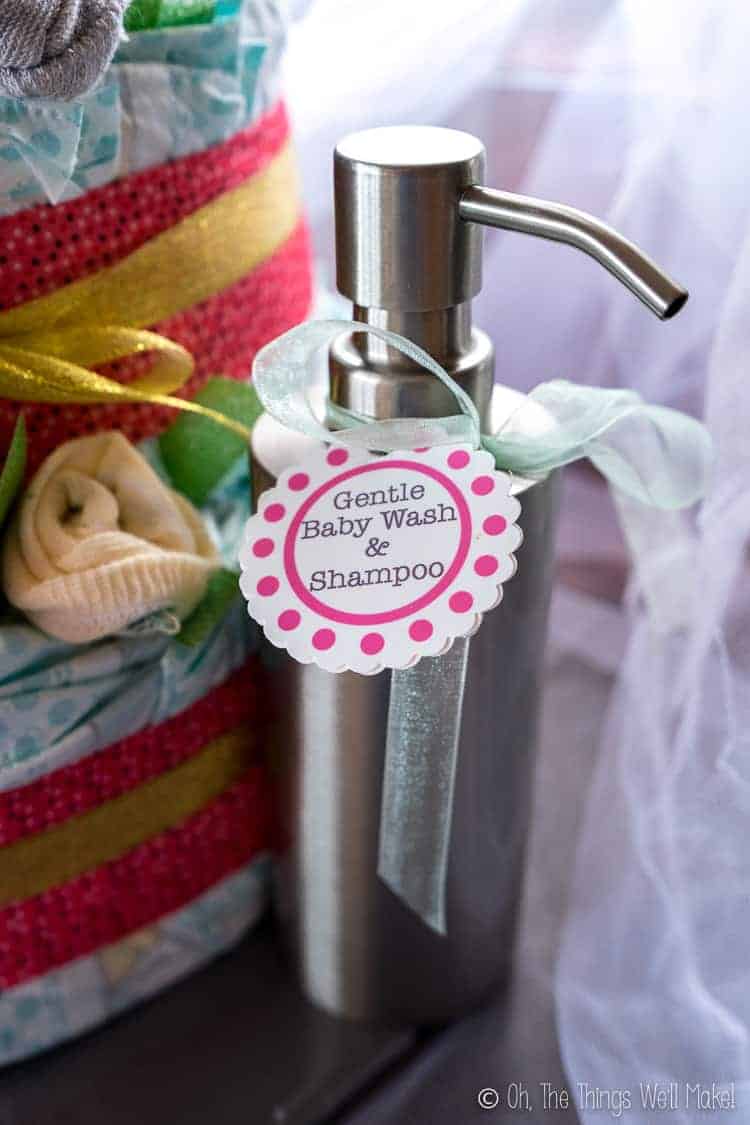
People have been asking me for a recipe for a baby wash and/or shampoo for quite some time now. So, when I was invited to a friend’s daughter’s baptism, it was the perfect time to elaborate a homemade baby wash and shampoo as part of the gift.
I did a lot of research, played a lot with different formulas, and came up with something that I really like. It has a nice, gentle fragrance without any synthetic fragrances or essential oils. It’s mild enough for a baby, but can also be used for those with sensitive skin.
Because it’s pH is in a good range for both hair and skin, it can be used as both a mild shampoo and baby wash. When you already need so many other products for the new little one, why complicate things even more with one more unnecessary product, right?
Watch how to make this homemade baby wash and shampoo.
Why make your own baby wash and shampoo?
Let’s face it: despite the fact that many products are marketed for babies, they may have harsher ingredients that aren’t necessarily the best for a baby’s soft, delicate skin.
Many people try to use soap or make homemade baby washes using soap and other ingredients because they consider soap as the most “natural” solution. Unfortunately, the high pH of soap isn’t ideal for a baby’s delicate skin either. (No, not even those said to be “baby soaps.”)
It’s tempting to just rinse a baby with water, in an attempt to protect them from unnecessary chemicals, but, on the other hand, it’s not a good idea to leave urine and feces on a baby’s delicate skin either.
So, what should we do?
How is a baby’s skin different from an adult’s?
When a baby is born, their skin has to adapt from being in a wet environment to life outside the womb. At first, the outer layer (stratum corneum) of their skin hasn’t completely formed. It’s much thinner than an adult’s skin. It also begins with a higher pH but very quickly acidifies into the same range as ours.
Because that outer layer is so thin, a baby isn’t as protected as we are from environmental factors and chemicals. Their skin doesn’t adapt as quickly as ours to changes in pH and/or other outside “attacks.” Harsh surfactants can strip their skin of oils and leave a baby more predisposed to dry skin and/or rashes.
What should you avoid in a baby wash?
Because their skin is still developing, we want to ideally use mild products that fall in a pH range that won’t irritate their delicate skin. What, then, are the ingredients that we should avoid?
Some surfactants are much harsher than others
By now, most of you have probably heard conflicting arguments about a couple of surfactants, sodium lauryl sulfate (SLS) and sodium laureth sulfate (SLES). One of these two common surfactants is used in just about every cosmetic product out there, whether it be shampoo, shower gel, or even toothpaste.
Many of you would expect me to be an SLS hater, and that’s really not the case. It’s actually not that bad of a surfactant for certain uses. It cleans well, it’s inexpensive, it gives great lather, and it makes a beautifully smooth, thick gel when easily thickened with salt. It’s normally derived from coconut oil and it’s completely biodegradable. While some people claim it’s cancer-causing, I haven’t been able to find any evidence to back up that claim. That claim, in itself, is partly based on certain other claims like that SLS can react with formaldehyde to produce “nitrosating agents.” As neither have nitrogen atoms, that would be impossible. I wrote more about my thoughts on SLS in my laundry detergent recipe post because I used in in that recipe.
While I’m not an SLS hater, I do think it is overused. It’s one of the harsher surfactants, and I prefer not to use it in personal care products. In my opinion, it should never be used in a baby wash or shampoo.
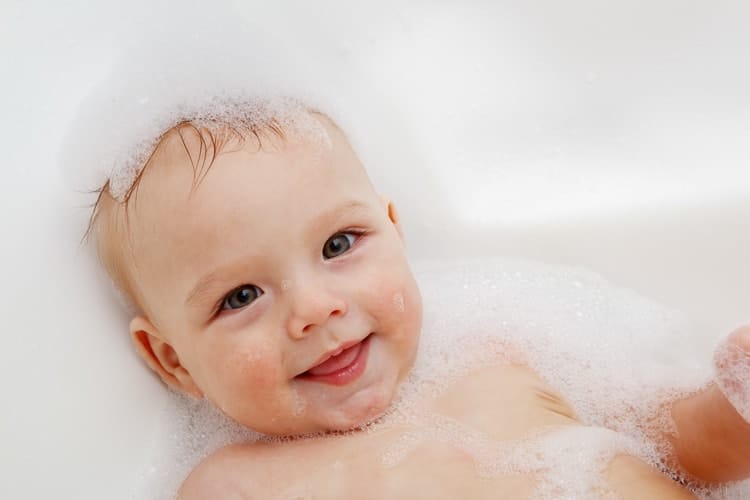
Is Castile soap safe for babies?
Many of you know me because of my soap recipes. I love making both liquid and bar soaps and have been known to use soap for just about everything. There have been a few exceptions, though. Soap may be, or at least seem like, the most natural option for cleaning, but that doesn’t mean it’s always the best solution.
The problem with soap is that it naturally has a high pH.
By now, you probably know that I don’t use soap on my hair. I shared my experiences and opinions on soap-based shampoos in both my post with a recipe for a liquid shampoo and my bar shampoo recipe. The high pH leaves my hair feeling like straw, and the vinegar rinse recommended to restore the pH after using a soap-based shampoo really doesn’t improve matters much (for me).
Our hair and skin both fall into an acidic pH range. Using soap (which is always alkaline) on our skin will raise the pH temporarily. Luckily, the change in pH is only temporary, and for most of us, that means we can use natural soap on our skin to clean it without seeing any ill effects. The pH falls back to normal within a half hour or so. Some people are more sensitive to that change, though, and may find soaps to be more drying to their delicate skin. (Others may find that soap actually helps certain skin conditions.)
When can that high pH have a negative effect?
Our hair is mostly dead, which is why it can’t recover as easily as our skin and why most of us will find that using soap on our hair will eventually damage it.
With a baby’s skin having an undeveloped outer layer, I suspect that the high pH can have more of an effect on their skin than ours too.
So, despite having defended in the past the idea that using pH balanced cleansers on our skin isn’t really necessary, knowing what I know now, I prefer to avoid using soap for a baby’s sensitive skin to err on the side of caution. While the skin of most babies should be able to recover from the temporary changes to pH, it is also more likely to take longer to recover. That means, it’s more likely to be negatively affected by the high pH.
Does that mean that I’m saying that soap isn’t safe for a baby’s skin? No, I don’t think it’s unsafe either, I’m just not convinced it’s the best solution for cleaning babies. Some people may use and be perfectly content to use soap on their baby’s skin. Others may find it too drying.
I wanted to provide another mild option for those looking for a non-soap solution!
Other common ingredients to avoid
- Parfum: Synthetic fragrances and unknown chemicals are hidden under the term “parfum.” I like to even avoid “natural fragrances” because we have no real way to know what’s in those ingredients either.
- PEGs (polyethylene glycols) are also commonly found in baby shampoos and gels. (They are usually labelled as PEG-X with the X being a number.) They are normally used as emollients or emulsifiers, but they can be contaminated with toxic impurities like ethylene oxide or 1,4-dioxane. They also change the surface tension of the skin, which means that not only could other not-so-great ingredients can get further down into the skin, but that the moisture barrier could be more compromised. I avoid using them in all cosmetics, but I think it’s even more important to avoid them in a baby product since their skin barrier is already somewhat compromised.
- Parabens are effective preservatives, but they also activate the same estrogen receptor as the natural hormone estradiol- which is why they are said to be estrogenic. While many argue that these preservatives are safe, I prefer to avoid hormone-mimicking ingredients, when possible, especially for young children. There are many safer, more natural preservatives available.
- Essential oils: While I love using essential oils to give a nice, natural fragrance to my homemade products, I decided against using them in this baby shampoo and gel. While certain EO’s, like lavender, are thought to be mild, most aren’t recommended for babies under 6 months. While they aren’t likely to cause problems, I feel safer avoiding them in baby products, when possible. I chose to use a floral water to give this product a mild, natural scent that is perfectly gentle.
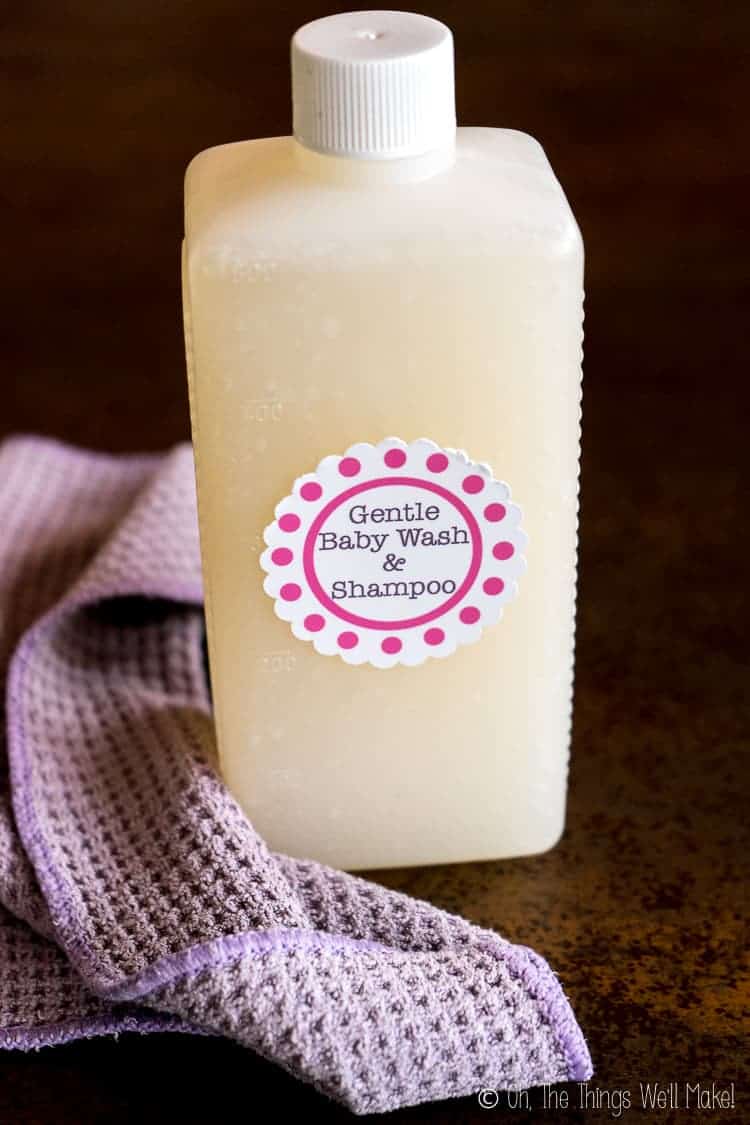
What ingredients did I use instead?
Mild surfactants
I chose to use two gentle, natural, coconut-derived surfactants, coco glucoside, and coco betaine. (For more information about them, you can read my beginner’s guide to natural surfactants.)
Coco glucoside is an ECOCERT/COSMOS approved mild surfactant from the glucoside family of nonionic surfactants. Because it is so mild and is known to be gentle on hair, it is commonly found in baby cosmetics and shampoos. It’s also used in conjunction with other surfactants to lessen possible irritation caused by them.
Coco Betaine is another ECOCERT/COSMOS approved mild surfactant. This one is amphoteric and is usually used in combination with other surfactants to help increase viscosity, boost cleansing and foam stability, all while reducing irritation of the other surfactants.
Water-Based Ingredients
Rather than use essential oils to give this homemade shampoo and gel a mild, natural fragrance, I chose to use rose water/hydrosol instead. It’s known to be a calming scent for babies, and it’s mild and not at all overbearing.
I also chose to use aloe juice as one of the water components.
You can sub out either the aloe juice or the rose water (or both) and exchange them for more distilled water instead. That will leave you with a more unscented product.
Thickener and humectant
Xanthan gum is a thickener often chosen for more natural-based products. In this case, the mild surfactants I chose can’t be thickened with salt, so I needed to look for another option. If this shampoo were too thin, it would be difficult to apply and you’d likely use too much. It’s also more likely that you’d get the shampoo in your baby’s eyes. that’s why thickening the baby wash is important.
Because xanthan gum can be tricky to dissolve, I added some glycerin to this recipe. Glycerin is a humectant that will help draw moisture to the skin. Xanthan gum can be pre-dissolved in glycerin to make it easier to incorporate into the rest of the recipe.
If you don’t want to use glycerin, you may have to do a bit more mixing to get the xanthan to be fully dissolved and distributed into the shampoo/gel. You could also substitute the glycerin for a glycerite/glycerin-based extract like chamomile extract or cucumber extract to add in other desired botanicals.
You can adjust the amount of xanthan gum up or down to personalize the viscosity to suit your taste. I’ve found that xanthan gums can vary quite a bit, too, so while 2g of one xanthan gum might make a perfect gel, a gum from a different supplier may make a way-too-thick, hard-to-use gloopy mess. To avoid using too much, start with a smaller amount and slowly add more in as needed.
(I actually made this mistake when making my video for this post. I was actually trying out a new type of xanthan gum and went right to adding in the 2g directly and ended up with a thick, gloopy mess. I had to add more water, surfactants, and preservative to make it useable again.)
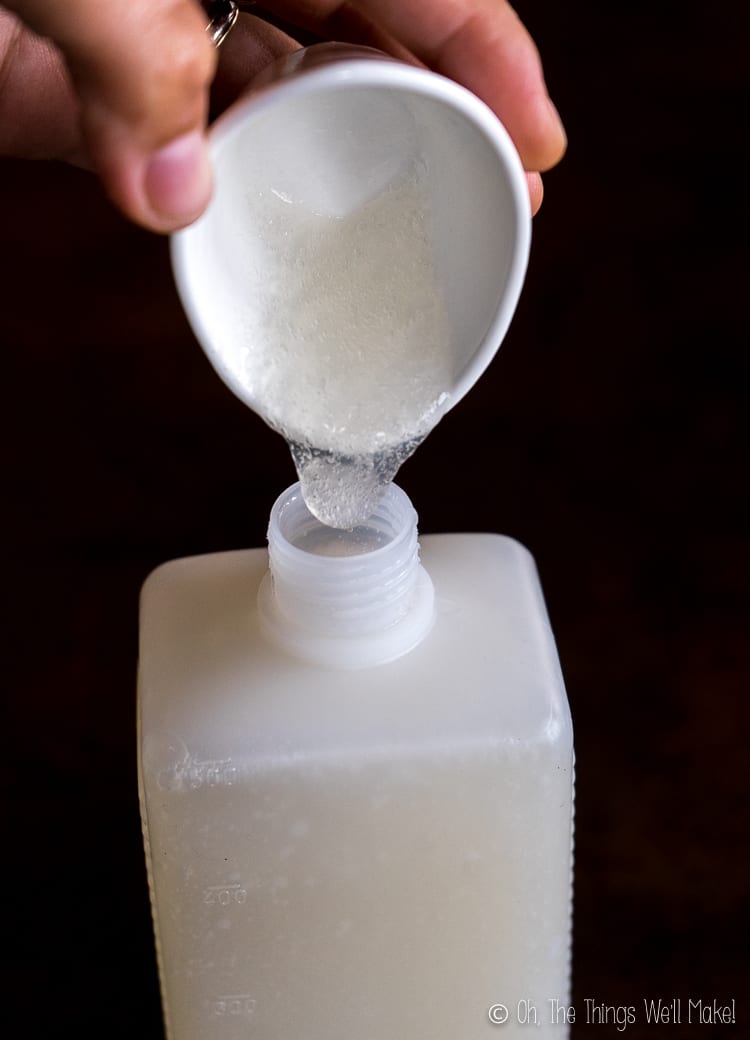
Natural preservative
There are a number of natural preservatives that can be used to prevent microbial growth in this product. (I’m working on a guide to natural preservatives now, so look forward to it!) 😉
I used Sharomix 705 in my homemade baby wash, but you can use other preservatives like preservative ECO, Rokonsal, Cosgard/Geogard, Euxyl K903, etc.
Make sure to use the preservative you choose in the recommended amount for the recipe. (Most are used at around 0.5-1% of the recipe, but some, like Leucidal, may need to be used in a higher percentage by weight to be effective.)
You should also make sure that your final product is in a pH in which your preservative is effective.
pH Adjuster
To lower the pH of my homemade baby wash and shampoo, I used a few drops of lactic acid. You can use other acids, like citric acid, to lower the pH as needed. Although unlikely, if you needed to raise the pH of the gel, you can use a sodium hydroxide (NaOH) solution.
The ideal pH for this baby shampoo
There are two different lines of thinking about the ideal pH for a baby shampoo and gel. Some people believe that a baby shampoo should be pH neutral so that it is tear-free. Others believe that the baby shampoo should be formulated to be in the ideal range for their skin, despite the fact that it may be more irritating to a baby’s eyes.
What is a tear-free shampoo?
Tear-free shampoos are usually formulated to a near neutral ph (around 7.5). That’s because most eye irritation comes from a deviation of the pH of the eyes. Because a baby’s blink reflex isn’t very developed yet, they are much more likely to get the soap into their eyes. So, making a more “tear-free” product sounds like a good idea.
On the other hand, many people argue that if a baby doesn’t complain when he or she gets shampoo in their eye, you wouldn’t really know there was a problem, and wouldn’t rinse it out. Leaving it there could cause problems later on.
Also, the ideal pH for the eyes isn’t the ideal pH for skin and hair.
An ideal pH for skin and hair
While it’s true that a baby’s skin begins with a higher pH, it soon falls into the more acidic range of our skin and hair (between 4.5-6).
I decided to bring this shampoo to a pH of around 5.5 because I feel that is the ideal pH for a product meant for both skin and hair.
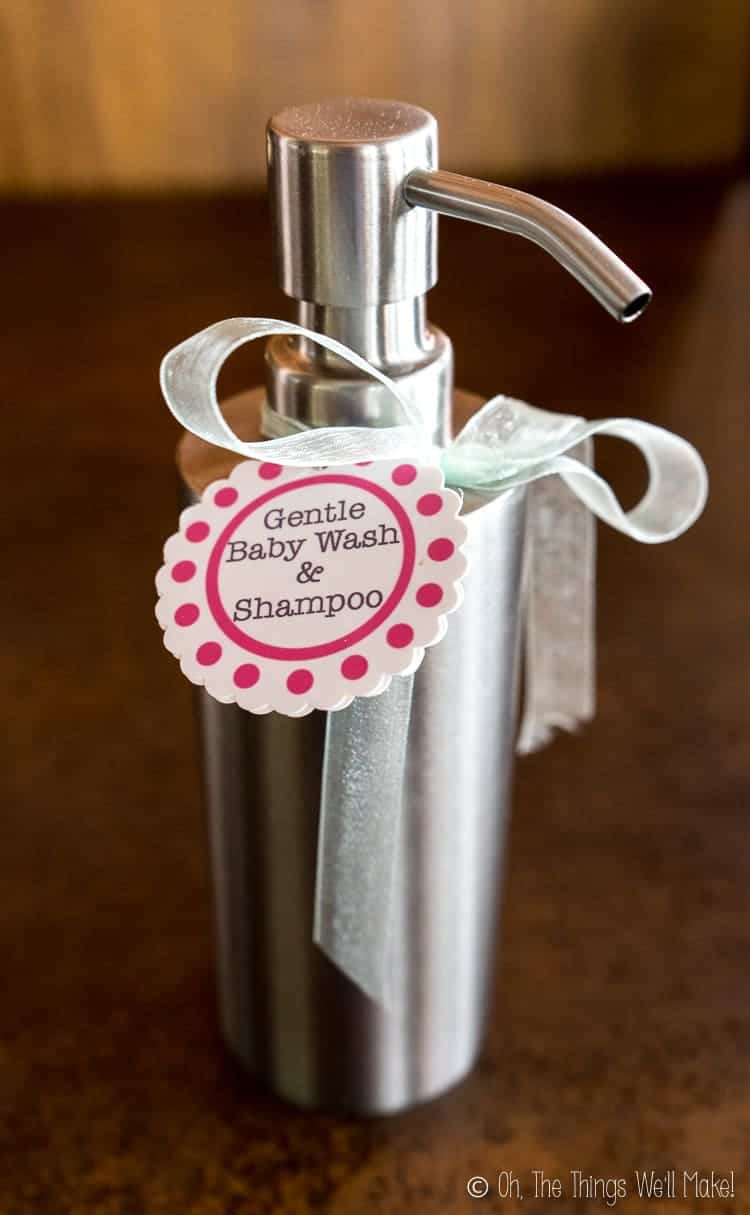
DIY Baby Wash and Shampoo
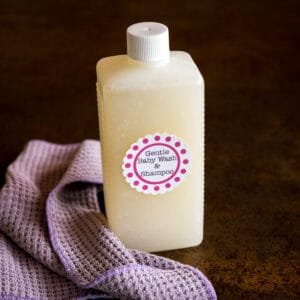
Homemade Baby Wash and Shampoo (No Soap)
Equiment
Materials
- 28 g distilled water
- 20 g rose water
- 20 g aloe juice
- 15 g coco glucoside (or decyl glucoside)
- 10 g coco betaine
- 4.25 g glycerin (or glycerin-based extract)
- 2 g xanthan gum
- .75 g Sharomix 705 (or another natural preservative in amount needed)
Instructions
- Sprinkle the xanthan gum powder over the glycerin or glycerite, and gently mix it into the glycerin as well as you can.
- Weigh out and mix the other ingredients together gently.
- Slowly begin to add in the xanthan gum and glycerin mixture, checking on the texture after each addition. Keep adding and mixing it in until you get to the desired viscosity.
- Pour the finished gel into a dispenser of choice. Ideal dispensers are those with flip tops and/or pump dispensers.
Labeling your homemade baby wash
I ended up making a couple of labels to tie onto the stainless steel dispenser that I used to gift my homemade gel. One label has the name of the product. The other one has the ingredient list. Technically, I should have written out the ingredients of the Sharomix preservative, but since this was a gift and not something for sale, I didn’t get too technical with it. I did what fit best on the label.
You’re free to use my labels. I printed them out together onto a 4×6 inch (10x15cm) card. I then cut out the circles with a 2-inch craft punch and glued them together. I punched a hole in the top and tied it to the dispenser. You could also glue the labels to the bottle as I did with the plastic bottle shown above.
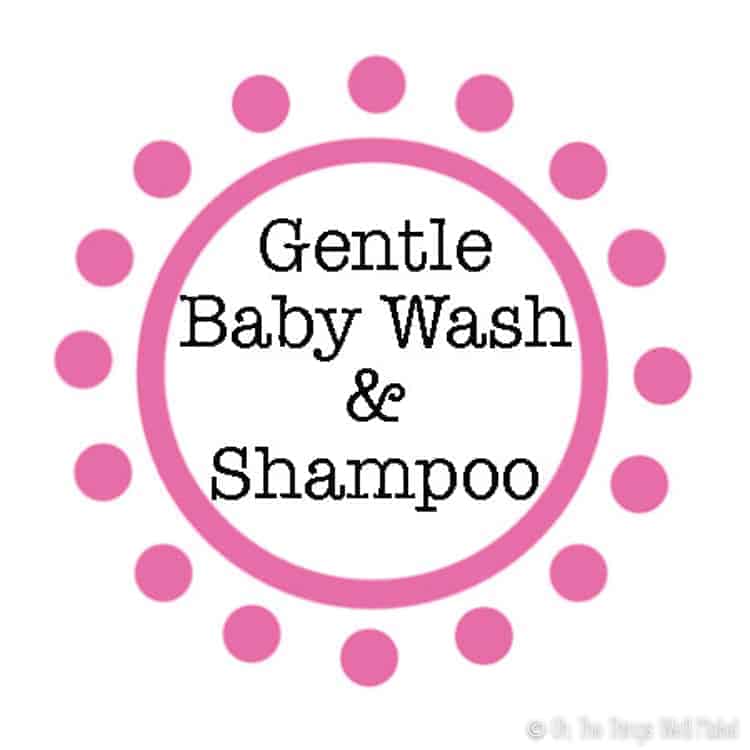
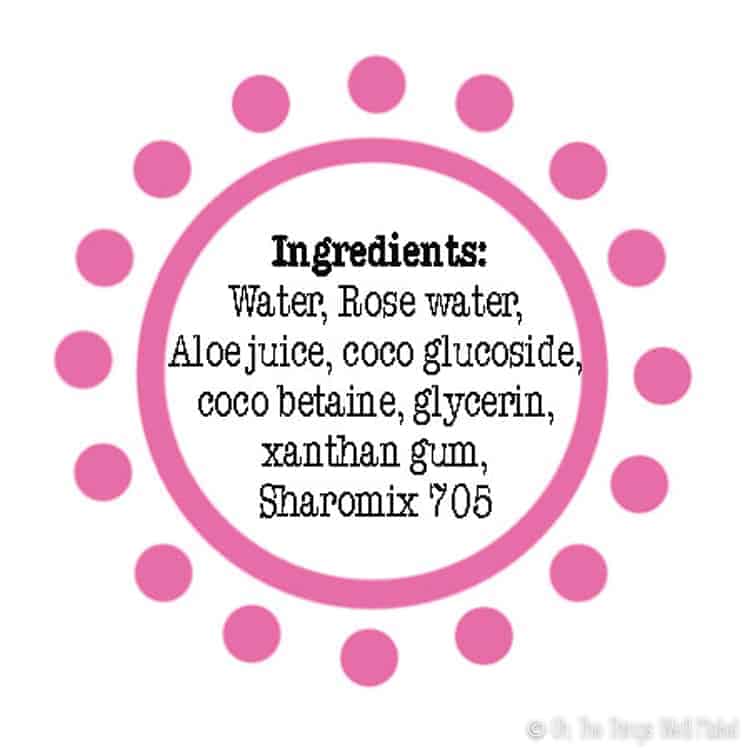
 Español
Español
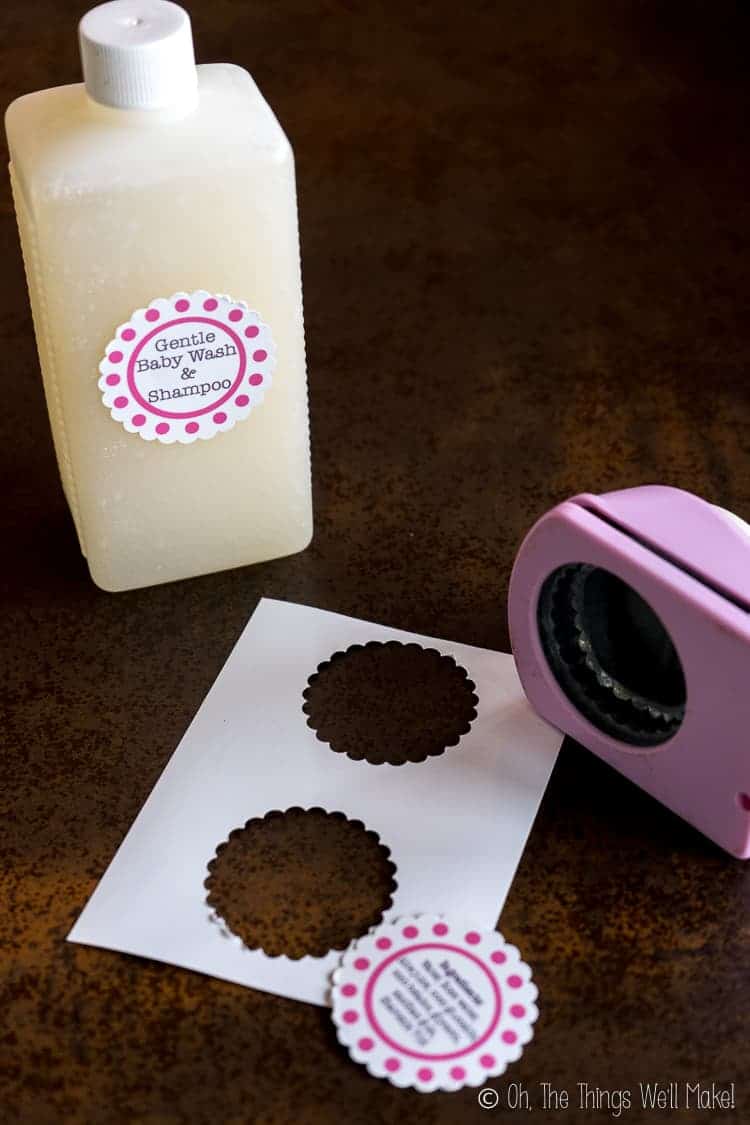
 Beginner-Friendly Ladybug Mandala Rock Painting Tutorial
Beginner-Friendly Ladybug Mandala Rock Painting Tutorial
amani
Hi tracy,
I wanted to know if the recipe is tear-free even if it’s ph 5.5, I did not completely understand if it did.
Thank you
Tracy Ariza, DDS
No, they don’t generally consider it tear free, but it is better for you hair. Most people feel it’s best to worry more about getting the pH right and then doing it best to keep it out of the baby’s eyes as any pH, even “tear free”, will cause irritation.
Nani
Hi,
How long is this recipe good for? 2 weeks?
Thanks
Tracy Ariza, DDS
If you use the preservative, it should keep well up to 3 months without issues. (Probably much longer, but I like to err on the side of caution with homemade products, especially for babies!)
Alison B
Thank you so much for this! The little guy I’m working with has such sensitive skin and I want to make something for him with added oils. Is it possible to add moisturizing oils to this like olive or argan?
Tracy Ariza, DDS
Hi Alison,
While surfactants often do have some solubilizing functions that would allow for some of the oil to combine with the other ingredients, generally, oils will separate from a product like this. You can normally add a gram or two of essential oil and maybe slightly more, but can’t add a lot of oils without getting separation. Also, adding oils can make this less effective as a cleanser.
To be honest, if it were me, I’d leave this as a gentle cleanser, using it as sparingly as possible. (My son also has very sensitive skin and I only used cleansers when necessary. Otherwise, I just cleansed with water.) Then follow up with a gentle lotion (or oils).
Nada
Hi Tracy!
I made this shampoo today and it’s great recipe. I put too much xantan gum so it was difficult to put in bottle but my hair Is beautiful.
I am a dentist like you but after ten years i decided to change Job.Now i am soapmaker and teacher:)
Wish you all the best!
Tracy Ariza, DDS
Hi Nada,
Wow, sounds like you and I are a lot alike, then! 🙂
When I update, I will mention that you may have to adjust the amount of xanthan depending on the one you have. I bought different ones from the same supplier (one was transparent and the other wasn’t) and they thickened differently. I brought it up with the tutor of the haircare product formulation class I was taking at the time and she said that it’s an ingredient that can vary quite a bit. So, yes, you may have to experiment a bit to get it right with the particular one you have at home!
Zara
Hi there,
I just found your blog and enjoyed reading and watching it. I have one question to ask though. How easily you can incorporate the gum into the mixture? I have tried more than 100 time with different methods to add cellulose gum into my surfactant system but after a week or so the gum started to sink to the bottom of the bottle.
* 0.5g gum + 4g glycerin, made a slurry, then mixed it in water then the surfactants
* I tried hot and cold processes.
* I even tried stick blending it for 20 minutes (now you think I am crazy 🙂 but the result was still the same.
I really appreciate if you can give me some suggestions. Thanks in advance.
Tracy Ariza, DDS
Hi Zara,
What type of gum are you using specifically?
I do find that sometimes I get separation with some gums, but normally not that quickly. I’ve stick blended before to help incorporate it better, and that usually has worked for me to get it stable for quite some time. It doesn’t always make it completely stable permanently, though, and sometimes I’ve had to shake the bottle before using. For me, that isn’t an isse, but I can understand it being problematic if you want to sell your product.
I actually asked this same question of a professional formulator because I didn’t stick blend and did have issues with separation, and she suggested blending it too. (So, no, you aren’t crazy. 20 minutes is more than what I’ve tried, but I get it… desperation can have us try just about anything.)
I’d suggest maybe trying a different type of gum. Other than that (and blending with some help from an appliance- as you’ve already done), I’m not sure what else to suggest. I wish I could be of more help.
If you’re lucky, and are using surfactants that allow you to thicken with salt (like I do in my laundry detergent), that is much more stable and nicer to look at. Unfortunately, it doesn’t work with most of the natural preservatives.
J
Hi Tracy! I was wondering if we can replace aloe juice with aloe gel, because thats what I have on hand.
Tracy Ariza, DDS
While it should be OK, the problem with using a gel is that you are adding other unknown ingredients. Aloe is difficult to preserve, so aloe gels often have stronger preservatives. They also vary quite a bit by which ingredients they use to make a thick gel. Most ingredients should react fine with the ingredients of this shampoo, but as the ingredients of your aloe gel are unknown to me, I just want you to be aware.
Priya
I have tried this shampoo, came out well.. but ph alone is high, to reduce that, it needs citric acid (a little high amount). any other suggestions
Tracy Ariza, DDS
Hi Priya,
They sell lactic acid for cosmetic use that is usually quite low in pH. You normally only need a few drops at most to adjust. Citric acid can be made into a solution to use, but, yes, you generally need more of it to lower the pH. It’s not that big of a deal as long as you aren’t adding so much that you’ve increased the amount of final product to the point that you no longer fall into the correct dosing for your preservative. (I hope that makes sense.)
Kari
Where do you purchase Sharomix 705? I can’t seem to find it online.
Tracy Ariza, DDS
Hi Kari,
I buy it locally here in Spain from several places, actually, but mainly from cremas-caseras.es. While I know they do send internationally, it may be easier for you to find some other preservative locally. Maybe check out my guide to natural preservatives to see if one of the ones there is easier for you to find.
Karen
Hi Tracy
Thank you for posting this really lovely baby shampoo/wash recipe. I have both of the surfactants that you use but believe that surfactants have different percentages of active matter in them – depending on where you obuy them from. Would you mind either letting me know what the active matter % is for both of them or ak,ternatively, letting me know what make you use so I can look it up?
Many thanks for such an interesting and infortmative post
Karen
Tracy Ariza, DDS
Hi Karen,
My coco betaine has around 30% active matter. I can’t read the label anymore for the coco glucoside. (I actually have that from several suppliers, but don’t have the information for either of them.) The decyl and laurel glucosides have just over 50% active matter, though. I think they tend to be around the same.
I’ve bought from different suppliers before and have compared, and they generally are sold at around the same concentrations. I guess it could vary from place to place, though.
Isabel
Hello there!
I was just wondering if this could be altered so there is no aloe present? I have an extremely sensitive scalp and aloe is in fact an irritant for me.
If so how would I go about this?
Thank you so much!!
Tracy Ariza, DDS
Hi Isabel,
Yes, of course! Just replace the aloe with distilled water!
Rev
Hello, Can I replace “coco betaine” with “Cocamidopropyl Hydroxysultaine” in baby wash/shampoo recipe? If yes, will the measurements be the same?
Tracy Ariza, DDS
Hi Rev,
I’ve never used Cocamidopropyl Hydroxysultaine, but it appears to be another amphoteric surfactant (like coco betaine).
It does appear to be listed as mild, so I would imagine that it would be a good substitute.
The real test it trying it out to see if you like the final product, but I don’t foresee any problems with it.
Chelbs
Hi Tracy,
You have been such a huge help to my journey into diy! I was wondering if I could lower the ph using ascorbic acid If so do I add it directly to the solution or make watered down solution. If not can i do citric acid and add it directly to it or also do a watered down version then add that? Thank you in advance for any help!
Tracy Ariza, DDS
I’ve never tried with ascorbic acid, but it should theoretically work fine. I have diluted citric acid in water, and then I add it in small increments at the end. I mix it in carefully and then test the pH before adding more.